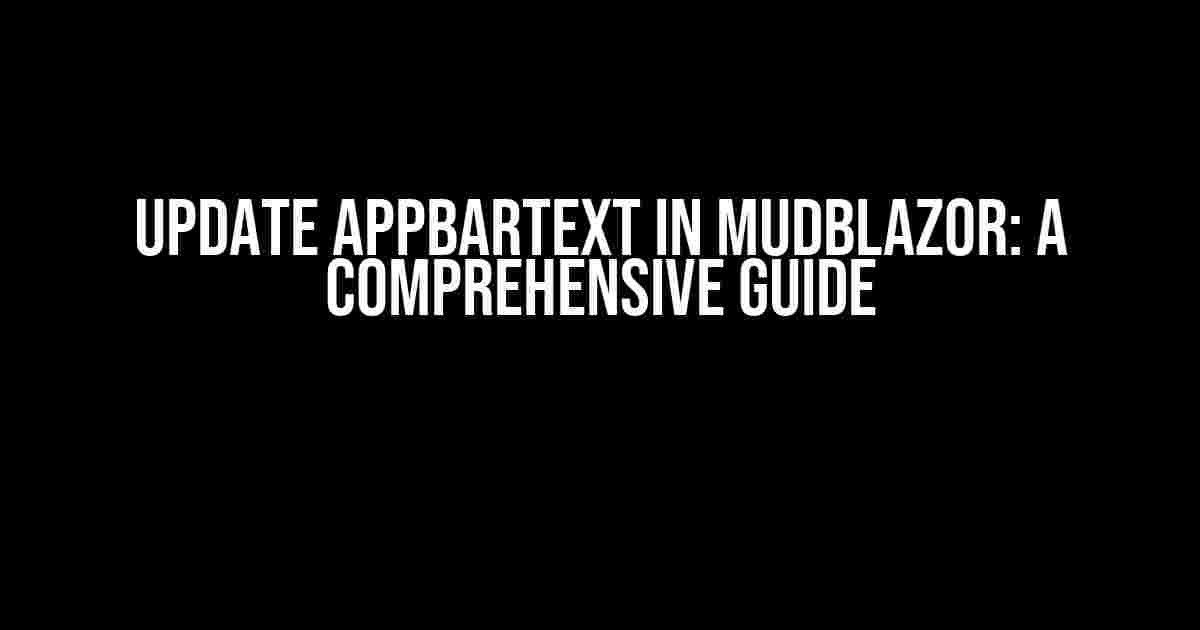Are you tired of being stuck with a static AppBarText in your MudBlazor application? Do you want to learn how to dynamically update it to reflect the current state of your app? Look no further! In this article, we’ll take you on a step-by-step journey to master the art of updating AppBarText in MudBlazor.
Why Update AppBarText?
Before we dive into the implementation details, let’s talk about why updating AppBarText is important. A well-designed AppBar is essential for providing a seamless user experience in any web application. It serves as a navigation hub, allowing users to access different parts of your app with ease. However, a static AppBarText can become stale and uninteresting, leading to a worse user experience.
By updating AppBarText dynamically, you can:
- Reflect the current state of your app
- Provide real-time feedback to users
- Enhance the overall user experience
Pre-requisites
Before we begin, make sure you have the following:
- A basic understanding of MudBlazor and its components
- A MudBlazor project set up with the necessary dependencies
- A AppBar component in your MudBlazor app
Method 1: Using a Variable
The first method to update AppBarText is by using a variable. This approach is straightforward and easy to implement.
Step 1: Declare a Variable
In your `.razor` file, declare a string variable that will hold the AppBarText:
@code {
string appBarText = "Initial AppBar Text";
}
Step 2: Bind the Variable to the AppBarText
Update the AppBar component to bind the `appBarText` variable to its `Text` property:
<MudAppBar @bind-Text="@appBarText" />Step 3: Update the Variable
To update the AppBarText, simply update the `appBarText` variable. For example:
@code {
string appBarText = "Initial AppBar Text";
void UpdateAppBarText() {
appBarText = "Updated AppBar Text";
StateHasChanged();
}
}
Call the `UpdateAppBarText` method whenever you want to update the AppBarText. The `StateHasChanged` method is used to notify the component that the state has changed, causing a re-render.
Method 2: Using a Service
The second method to update AppBarText is by using a service. This approach is more scalable and flexible, especially in larger applications.
Step 1: Create a Service
Create a new service class that will hold the AppBarText:
public class AppBarService {
public string AppBarText { get; set; }
}
Step 2: Inject the Service
Inject the `AppBarService` into your component:
@inject AppBarService appBarService
Step 3: Bind the Service to the AppBarText
Update the AppBar component to bind the `appBarService.AppBarText` property to its `Text` property:
<MudAppBar @bind-Text="@appBarService.AppBarText" />Step 4: Update the Service
To update the AppBarText, update the `AppBarText` property in the `AppBarService`:
void UpdateAppBarText() {
appBarService.AppBarText = "Updated AppBar Text";
}
Call the `UpdateAppBarText` method whenever you want to update the AppBarText.
Common Pitfalls and Solutions
When updating AppBarText, you might encounter some common pitfalls. Let’s address them:
| Pitfall | Solution |
|---|---|
| The AppBarText is not updating | Make sure to call `StateHasChanged` in the `UpdateAppBarText` method |
| The AppBarText is not reflecting the updated value | Verify that the `AppBarText` property is being updated correctly in the service or variable |
Best Practices
When updating AppBarText, keep the following best practices in mind:
- Use a consistent naming convention for your variables and services
- Keep your code organized and maintainable
- Use the `@code` block to separate your code from your markup
Conclusion
In conclusion, updating AppBarText in MudBlazor is a straightforward process that can greatly enhance the user experience in your web application. By following the methods outlined in this article, you can dynamically update the AppBarText to reflect the current state of your app. Remember to avoid common pitfalls and follow best practices to ensure a smooth and seamless experience for your users.
Happy coding!
Here is the FAQ section about “Update AppBarText in MudBlazor”:
Frequently Asked Question
Get the most out of MudBlazor by solving these common queries about updating AppBarText!
How do I update the AppBarText in MudBlazor?
You can update the AppBarText in MudBlazor by using the `SetAppBarText` method provided by the `MudAppBar` component. Simply call this method and pass the new text as a parameter to update the AppBarText.
Can I update the AppBarText dynamically based on user interactions?
Yes, you can update the AppBarText dynamically based on user interactions. Simply call the `SetAppBarText` method within the event handler of the user interaction, and pass the new text as a parameter.
Do I need to use a specific syntax to update the AppBarText?
No, you don’t need to use a specific syntax to update the AppBarText. Simply call the `SetAppBarText` method and pass the new text as a parameter, and MudBlazor will take care of updating the AppBarText for you.
Can I update the AppBarText from a child component?
Yes, you can update the AppBarText from a child component by using a callback function or a service to communicate with the parent component that contains the AppBarText.
Will updating the AppBarText cause a re-render of the entire app?
No, updating the AppBarText will not cause a re-render of the entire app. MudBlazor uses a virtual DOM to optimize rendering, so only the AppBarText will be updated, without affecting the rest of the app.
